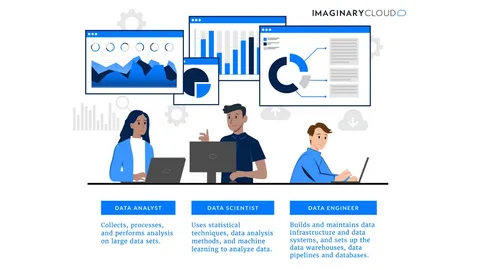Handling large datasets efficiently is a crucial skill for any data professional today. As data continues to grow exponentially, tools that can scale with it are becoming indispensable. Pandas has been the go-to library for data manipulation in Python, but it struggles when working with very large datasets that don’t fit into memory.
This is where Dask comes in. It extends the familiar Pandas API while adding parallel computing capabilities that can scale from a laptop to a distributed cluster. For those pursuing a Data Science Course, understanding when and how to use these tools is vital.
Understanding Pandas: Strengths and Limitations
Pandas is one of the most widely used libraries in Python for data analysis. It offers powerful data structures like DataFrames and Series, and comes packed with features for data manipulation, aggregation, and cleaning.
However, its performance is bound by single-core processing, and its operations are all in-memory. This makes it inefficient for large-scale datasets that exceed available RAM. While it’s ideal for prototyping and handling medium-sized datasets, performance quickly degrades when working at scale.
Enter Dask: Designed for Scalability
Dask is an open-source parallel computing library that scales the Python data science ecosystem. It allows you to work with datasets that are larger than memory and run computations on multiple cores or even distributed systems.
Dask’s DataFrame API mirrors that of Pandas, which makes it easy to transition. The primary advantage is its ability to process chunks of data in parallel, leading to faster computation times for large datasets.
Learning about Dask is essential in any good course, especially for students aiming to work in big data environments.
Performance Comparison
In terms of speed, Pandas can often outperform Dask when dealing with various small to medium-sized datasets. Its low overhead and optimization make it fast and efficient.
But when data scales, Dask takes the lead. It divides datasets into partitions and processes them in parallel, offering substantial performance improvements.
For batch processing and automated pipelines, Dask’s scalability provides a significant edge. Professionals enrolled in a data scientist course in Hyderabad are encouraged to benchmark both libraries to understand where each excels.
Memory Management
Memory is a critical constraint in data processing. Pandas loads entire datasets into memory, which can cause crashes or performance bottlenecks.
Dask, on the other hand, uses lazy evaluation and processes data in chunks, significantly reducing the memory footprint. This architecture allows for the analysis of datasets that would otherwise be impossible to load with Pandas alone.
Courses that include memory management strategies often highlight this difference. Anyone pursuing a course will benefit from understanding how to manage memory efficiently in real-world projects.
Ease of Use and Learning Curve
One of the strengths of Pandas is its simplicity and intuitive syntax. It’s an excellent tool for beginners and provides immediate feedback when learning.
Dask has a steeper learning curve, particularly when it comes to debugging and optimization. However, for those who are already familiar with Pandas, the transition isn’t too difficult, thanks to its similar API.
Parallelism and Distributed Computing
Parallelism is at the core of Dask. It can distribute computations across multiple cores or even machines in a cluster. This is a massive benefit for companies dealing with terabytes of data.
Pandas lacks built-in parallelism. While some workarounds exist, they often require third-party tools or manual intervention, which can complicate workflows.
Anyone aiming for a career in scalable data science workflows will encounter these topics in a comprehensive course.
Integration with Other Libraries
Both Pandas and Dask integrate well with the Python ecosystem. Pandas works seamlessly with libraries like Matplotlib, Scikit-learn, and Seaborn.
Dask, meanwhile, is designed to integrate with NumPy, Scikit-learn, and even TensorFlow. It can also be used in conjunction with cloud computing platforms, which makes it highly suitable for enterprise-level projects.
Students in a data science course gain exposure to these integrations, helping them build robust and scalable data pipelines.
Use Cases: When to Use Which
Use Pandas when:
- Working with small to medium datasets.
- Needing rapid prototyping and analysis.
- Operating within a limited resource environment.
Use Dask when:
- Working with large-scale data that doesn’t fit in memory.
- Running computations that need to scale across multiple cores or nodes.
- Deploying into a production environment with big data workflows.
Case Study: Data Processing in a Real-World Scenario
Imagine a retail company analyzing sales data from multiple outlets across the globe. The datasets are huge—spanning millions of records and updated in real-time.
Using Pandas would require downsampling the data or upgrading machine resources. With Dask, the company can process the full dataset in real time, providing quicker and more accurate business insights.
This example is commonly discussed in a data scientist course in Hyderabad, giving students practical exposure to high-volume data scenarios.
Challenges and Trade-Offs
Dask isn’t perfect. It may involve overhead during task scheduling and sometimes slower performance on small datasets due to its architecture.
Debugging in a distributed environment also requires additional knowledge and tools. However, the benefits far outweigh the downsides when dealing with scale.
In any course, learners are encouraged to weigh these trade-offs based on specific project needs.
Conclusion
Both Pandas and Dask have their place in the data science toolbox. While Pandas remains a staple for quick, in-memory data manipulation, Dask provides the scalability and parallelism needed for modern big data challenges.
Understanding when to use which tool is essential for building efficient and scalable data pipelines. For data professionals, especially those pursuing a data scientist course in Hyderabad, mastering both libraries opens the door to a wide range of analytical possibilities.
The evolution of tools like Dask is a reminder that data science is not just about analysis—it’s about building systems that can handle the complexity of today’s data-rich world.
ExcelR – Data Science, Data Analytics and Business Analyst Course Training in Hyderabad
Address: Cyber Towers, PHASE-2, 5th Floor, Quadrant-2, HITEC City, Hyderabad, Telangana 500081
Phone: 096321 56744

